#including insightful articles
Text
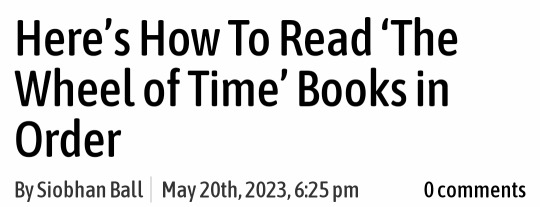
I couldn't help but click on this because I had no idea people had reading orders for wot. I mean, it's a pretty linear story and I wouldn't recommend reading them out of order?
Anyway, turns out this article endorses the controversial practice of starting with book one and proceeding in numerical order through book fourteen. I'm glad to be able to bring this helpful tip to anyone who was confused!
#how do i get paid to write such insightful articles#in fairness it also includes a short summary of each book but still . . . what is the point
317 notes
·
View notes
Text

she loves her best friend you stupid fuck
#screenrant really scrabbling for content huh#literally have never seen an article on my included news bulletin on media#hit an iota of the insight and nuance as the mutuals and philosophers of the dash#and these idiots grt PAID#cor.txt
9 notes
·
View notes
Text
@legend-tripper replied to your post “It took some convincing, but I got ChatGPT to write a prayer to Anna Sorokin. Maybe the references to "integrity and honesty"...”
do you want to write a prayer, frank?
Briefly, I wrote "pray for me" and then opened a browser window and pasted that in and let ChatGPT have at it, but the real goal is to compose sentences with a structure like "I need some guidance, please guide me to being more effective in my work / less stressed out, etc.
#kind of nerdbaiting#nevertheless it would be interesting#and also give me some insight into the process that led to these weirdly specific ideas#I wonder if part of the reason it includes 'integrity and honesty' is that its source was reading a newspaper article?
4 notes
·
View notes
Text
You're a reasonably informed person on the internet. You've experienced things like no longer being able to get files off an old storage device, media you've downloaded suddenly going poof, sites and forums with troves full of people's thoughts and ideas vanishing forever. You've heard of cybercrime. You've read articles about lost media. You have at least a basic understanding that digital data is vulnerable, is what I'm saying.
I'm guessing that you're also aware that history is, you know... important? And that it's an ongoing study, requiring ... data about how people live? And that it's not just about stanning celebrities that happen to be dead?
Congratulations, you are significantly better-informed than the British government!
So they're currently like "Oh hai can we destroy all these historical documents pls? To save money? Because we'll digitise them first so it's fine! That'll be easy, cheap and reliable -- right? These wills from the 1850s will totally be fine for another 170 years as a PNG or whatever, yeah? We didn't need to do an impact assesment about this because it's clearly win-win! We'd keep the physical wills of Famous People™ though because Famous People™ actually matter, unlike you plebs. We don't think there are any equalities implications about this, either! Also the only examples of Famous People™ we can think of are all white and rich, only one is a woman and she got famous because of the guy she married. Kisses!"
Yes, this is the same Government that's like "Oh no removing a statue of slave trader is erasing history :("
You have, however, until 23 February 2024 to politely inquire of them what the fuck they are smoking. And they will have to publish a summary of the responses they receive. And it will look kind of bad if the feedback is well-argued, informative and overwhelmingly negative and they go ahead and do it anyway. I currently edit documents including responses to consultations like (but significantly less insane) than this one. Responses do actually matter.
I would particularly encourage British people/people based in the UK to do this, but as far as I can see it doesn't say you have to be either. If you are, say, a historian or an archivist, or someone who specialises in digital data do say so and draw on your expertise in your answers.
This isn't a question of filling out a form. You have to manually compose an email answering the 12 questions in the consultation paper at the link above. I'll put my own answers under the fold.
Note -- I never know if I'm being too rude in these sorts of things. You probably shouldn't be ruder than I have been.
Please do not copy and paste any of this: that would defeat the purpose. This isn't a petition, they need to see a range of individual responses. But it may give you a jumping-off point.
Question 1: Should the current law providing for the inspection of wills be preserved?
Yes. Our ability to understand our shared past is a fundamental aspect of our heritage. It is not possible for any authority to know in advance what future insights they are supporting or impeding by their treatment of material evidence. Safeguarding the historical record for future generations should be considered an extremely important duty.
Question 2: Are there any reforms you would suggest to the current law enabling wills to be inspected?
No.
Question 3: Are there any reasons why the High Court should store original paper will documents on a permanent basis, as opposed to just retaining a digitised copy of that material?
Yes. I am amazed that the recent cyber attack on the British Library, which has effectively paralysed it completely, not been sufficient to answer this question for you. I also refer you to the fate of the Domesday Project. Digital storage is useful and can help more people access information; however, it is also inherently fragile. Malice, accident, or eventual inevitable obsolescence not merely might occur, but absolutely should be expected. It is ludicrously naive and reflects a truly unpardonable ignorance to assume that information preserved only in digital form is somehow inviolable and safe, or that a physical document once digitised, never need be digitised again..At absolute minimum, it should be understood as certain that at least some of any digital-only archive will eventually be permanently lost. It is not remotely implausible that all of it would be. Preserving the physical documents provides a crucial failsafe. It also allows any errors in reproduction -- also inevitable-- to be, eventually, seen and corrected. Note that maintaining, upgrading and replacing digital infrastructure is not free, easy or reliable. Over the long term, risks to the data concerned can only accumulate.
"Unlike the methods for preserving analog documents that have been honed over millennia, there is no deep precedence to look to regarding the management of digital records. As such, the processing, long-term storage, and distribution potential of archival digital data are highly unresolved issues. [..] the more digital data is migrated, translated, and re-compressed into new formats, the more room there is for information to be lost, be it at the microbit-level of preservation. Any failure to contend with the instability of digital storage mediums, hardware obsolescence, and software obsolescence thus meets a terminal end—the definitive loss of information. The common belief that digital data is safe so long as it is backed up according to the 3-2-1 rule (3 copies on 2 different formats with 1 copy saved off site) belies the fact that it is fundamentally unclear how long digital information can or will remain intact. What is certain is that its unique vulnerabilities do become more pertinent with age." -- James Boyda, On Loss in the 21st Century: Digital Decay and the Archive, Introduction.
Question 4: Do you agree that after a certain time original paper documents (from 1858 onwards) may be destroyed (other than for famous individuals)? Are there any alternatives, involving the public or private sector, you can suggest to their being destroyed?
Absolutely not. And I would have hoped we were past the "great man" theory of history. Firstly, you do not know which figures will still be considered "famous" in the future and which currently obscure individuals may deserve and eventually receive greater attention. I note that of the three figures you mention here as notable enough to have their wills preserved, all are white, the majority are male (the one woman having achieved fame through marriage) and all were wealthy at the time of their death. Any such approach will certainly cull evidence of the lives of women, people of colour and the poor from the historical record, and send a clear message about whose lives you consider worth remembering.
Secondly, the famous and successsful are only a small part of our history. Understanding the realities that shaped our past and continue to mould our present requires evidence of the lives of so-called "ordinary people"!
Did you even speak to any historians before coming up with this idea?
Entrusting the documents to the private sector would be similarly disastrous. What happens when a private company goes bust or decides that preserving this material is no longer profitable? What reasonable person, confronted with our crumbling privatised water infrastructure, would willingly consign any part of our heritage to a similar fate?
Question 5: Do you agree that there is equivalence between paper and digital copies of wills so that the ECA 2000 can be used?
No. And it raises serious questions about the skill and knowledge base within HMCTS and the government that the very basic concepts of data loss and the digital dark age appear to be unknown to you. I also refer you to the Domesday Project.
Question 6: Are there any other matters directly related to the retention of digital or paper wills that are not covered by the proposed exercise of the powers in the ECA 2000 that you consider are necessary?
Destroying the physical documents will always be an unforgivable dereliction of legal and moral duty.
Question 7: If the Government pursues preserving permanently only a digital copy of a will document, should it seek to reform the primary legislation by introducing a Bill or do so under the ECA 2000?
Destroying the physical documents will always be an unforgivable dereliction of legal and moral duty.
Question 8: If the Government moves to digital only copies of original will documents, what do you think the retention period for the original paper wills should be? Please give reasons and state what you believe the minimum retention period should be and whether you consider the Government’s suggestion of 25 years to be reasonable.
There is no good version of this plan. The physical documents should be preserved.
Question 9: Do you agree with the principle that wills of famous people should be preserved in the original paper form for historic interest?
This question betrays deep ignorance of what "historic interest" actually is. The study of history is not simply glorified celebrity gossip. If anything, the physical wills of currently famous people could be considered more expendable as it is likely that their contents are so widely diffused as to be relatively "safe", whereas the wills of so-called "ordinary people" will, especially in aggregate, provide insights that have not yet been explored.
Question 10: Do you have any initial suggestions on the criteria which should be adopted for identifying famous/historic figures whose original paper will document should be preserved permanently?
Abandon this entire lamentable plan. As previously discussed, you do not and cannot know who will be considered "famous" in the future, and fame is a profoundly flawed criterion of historical significance.
Question 11: Do you agree that the Probate Registries should only permanently retain wills and codicils from the documents submitted in support of a probate application? Please explain, if setting out the case for retention of any other documents.
No, all the documents should be preserved indefinitely.
Question 12: Do you agree that we have correctly identified the range and extent of the equalities impacts under each of these proposals set out in this consultation? Please give reasons and supply evidence of further equalities impacts as appropriate.
No. You appear to have neglected equalities impacts entirely. As discussed, in your drive to prioritise "famous people", your plan will certainly prioritise the white, wealthy and mostly the male, as your "Charles Dickens, Charles Darwin and Princess Diana" examples amply indicate. This plan will create a two-tier system where evidence of the lives of the privileged is carefully preserved while information regarding people of colour, women, the working class and other disadvantaged groups is disproportionately abandoned to digital decay and eventual loss. Current and future historians from, or specialising in the history of minority groups will be especially impoverished by this.
16K notes
·
View notes
Text
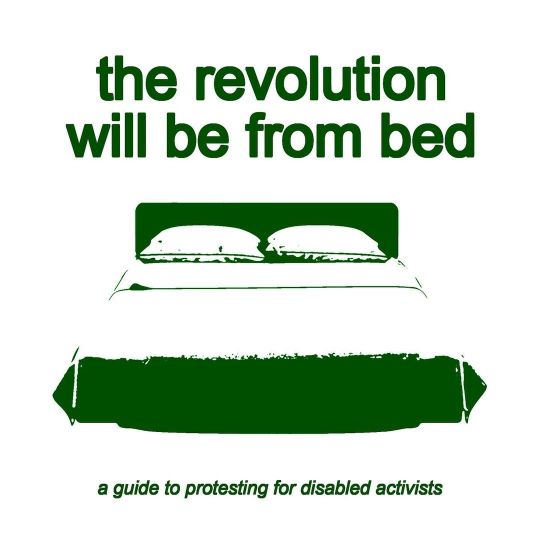
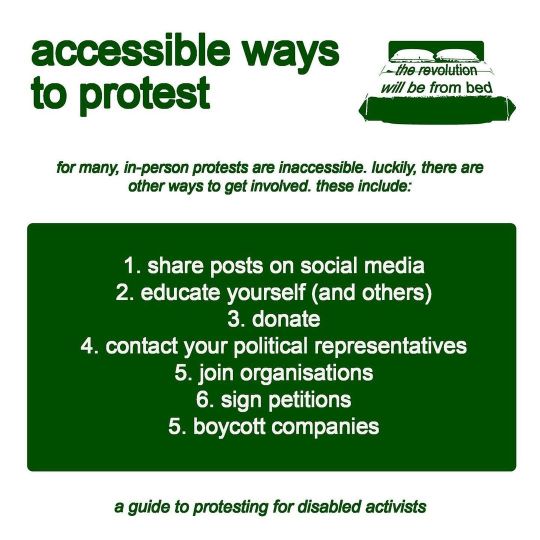
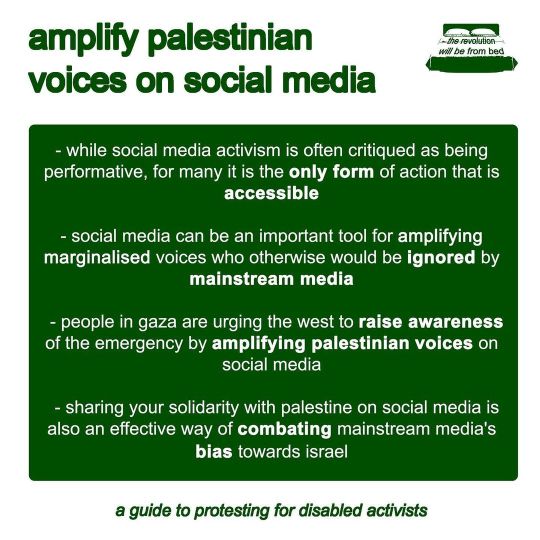

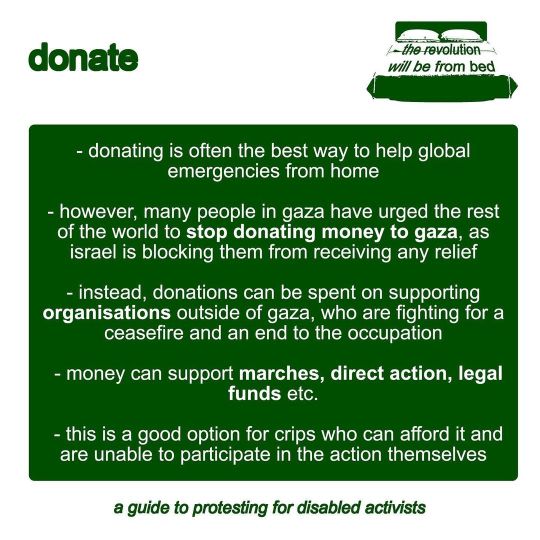
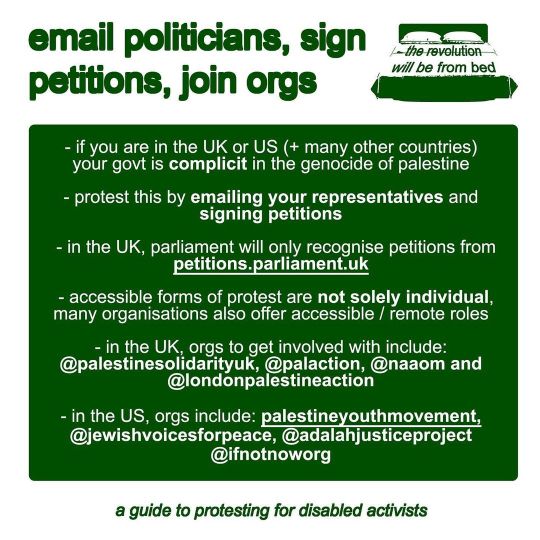
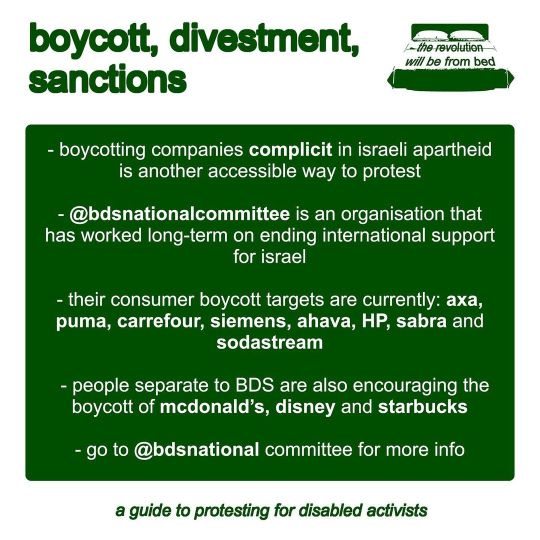


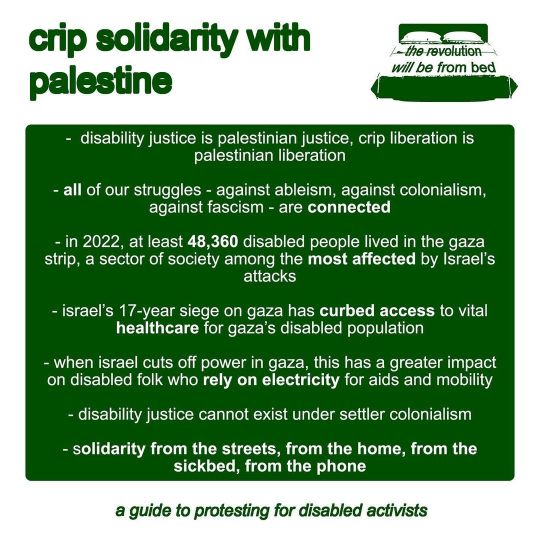
posted by cripthegig on instagram:
(finally) here’s the updated version of accessible ways to protest for palestine ! hopefully this will be more legible :) mentioned links and more accessible ways to support palestine in my linktree in my bio !
if you have any other suggestions about accessible action for palestine, please comment them below
i’ve also amended a few outdated elements of the post. go to the original post’s comments for some really valuable extra insights on the topic !
note to say that nothing in this list will be accessible to all, it is merely a list of suggestions for more accessible action. the topic is incredibly nuanced and that can be hard to get across through the limited means of an infographic.
-
slide 1: an infographic with green imagery on a white background. dark green text at the top of the image reads ‘the revolution will be from bed’. in the middle of the image is a dark green outlined image of a double bed. in the bottom of the image is dark green smaller text that reads ‘a guide to protesting for disabled activists’
slide 2: an infographic with green imagery on a white background. dark green text at the top of the image reads ‘accessible ways to protest’. below the text, is smaller text in dark green that reads ‘for many, in-person protests are inaccessible. luckily, there are other ways to get involved. these include:’ the focus of the image is a dark green rectangle with white text inside it. the text reads ‘1. share posts on social media
educate yourself (and others)
donate
contact your political representatives
join organisations
sign petitions
boycott companies’
in the bottom of the image is dark green smaller text that reads ‘a guide to protesting for disabled activists’
slide 3: an infographic with green imagery on a white background. dark green text at the top of the image reads ‘amplify palestinian voices on social media’. the focus of the image is a dark green rectangle with white text inside it. the text reads ‘ - while social media activism is often critiqued as being performative, for many it is the only form of action that is accessible
social media can be an important tool for amplifying marginalised voices who otherwise would be ignored by mainstream media
people in gaza are urging the west to raise awareness of the emergency by amplifying palestinian voices on social media
sharing your solidarity with palestine on social media is also an effective way of combating mainstream media's bias towards israel’
at the bottom of the image is dark green text that reads ‘a guide to protesting for disabled activists’
slide 4: an infographic with green imagery on a white background. dark green text at the top of the image reads ‘educate yourself and others’. the focus of the image is a dark green rectangle with white text inside it. the text reads ‘education is a crucial part of activism that can be done from home
you can learn about palestine from books, articles, podcasts, films and much, much more
sites like decolonisepalestine.com,
palestinesolisarity.org and bdsmovement.net are good places to start
social medica can be a good source of on-the-ground information from accounts like @eye.on.palestine
share these resources on social media and in person, have uncomfortable conversations
at the bottom of the image is dark green text that reads ‘a guide to protesting for disabled activists’
slide 5: an infographic with green imagery on a white background. dark green text at the top of the image reads ‘donate’. the focus of the image is a dark green rectangle with white text inside it. the text reads ‘- donating is often the best way to help global emergencies from home
however, many people in gaza have urged the rest of the world to stop donating money to gaza, as israel is blocking them from receiving any relief
instead, donations can be spent on supporting organisations outside of gaza, who are fighting for a ceasefire and an end to the occupation
money can support marches, direct action, legal funds etc.
this is a good option for crips who can afford it and are unable to participate in the action themselves’
at the bottom of the image is dark green text that reads ‘a guide to protesting for disabled activists’
slide 6: an infographic with green imagery on a white background. dark green text at the top of the image reads ‘email politicians, sign petitions, join orgs’. the focus of the image is a dark green rectangle with white text inside it. the text reads ‘- if you are in the UK or US (+ many other countries) your govt is complicit in the genocide of palestine
protest this by emailing your representatives and signing petitions
in the UK, parliament will only recognise petitions from petitions.parliament.uk
accessible forms of protest are not solely individual, many organisations also offer accessible / remote roles
in the UK, orgs to get involved with include: @palestinesolidarityuk, @palaction, @naaom and @londonpalestineaction
in the US, orgs include: palestineyouthmovement, @jewishvoicesforpeace, @adalahjusticeproject @ifnotnoworg’
at the bottom of the image is dark green text that reads ‘a guide to protesting for disabled activists’
slide 7: an infographic with green imagery on a white background. dark green text at the top of the image reads 'boycott, divesment, sanctions’ the focus of the image is a dark green rectangle with white text inside it. the text reads
' - boycotting companies complicit in israeli apartheid is another accessible way to protest
@bdsnationalcommittee is an organisation that has worked long-term on ending international support for israel
their consumer boycott targets are currently: axa, puma, carrefour, siemens, ahava, HP, sabra and sodastream
people separate to BDS are also encouraging the boycott of mcdonald's, disney and starbucks
go to @bdsnational committee for more info'
at the bottom of the image is dark green text that reads 'a guide to protesting for disabled activists'
slide 8: an infographic with green imagery on a white background. dark green text at the top of the image reads 'advice for crips attending a march’ the focus of the image is a dark green rectangle with white text inside it. the text reads
'- going to a march can pose serious risks to crips and it is important to consider these before attending
where they can, organisers should make efforts to ensure marches are accessible (eg an accessible route, info about accessible loos + covid caution)
plan your route (for london crips a document is made every week with info about the march's accessibility)
bring a buddy who knows your access needs
know your rights; go to greenandblackcross.org for bustcards
mask up, to protect your fellow crip and avoid surveillance’
at the bottom of the image is dark green text that reads ‘a guide to protesting for disabled activists’.
slide 9: an infographic with green imagery on a white background. dark green text at the top of the image reads 'a crip’s guide to packing for a protest’ the focus of the image is a dark green rectangle with white text inside it. the text reads
’ - a radar key to unlock accessible loos
medication (bring han expedie you're out for longer
energy sustaining drinks and snacks
earplugs / defenders for noise sensitivity
pain relief devices
check the weather - bring suncream / umbrellas and dress accordingly
a fully charged phone with a battery pack
a sunflower lanyard / pritned out medical information
-a mask (ideally N95)
a bustcard for legal advice in case of arrest’
at the bottom of the image is dark green text that reads ‘a guide to protesting for disabled activists’.
slide 10: an infographic with green imagery on a white background. dark green text at the top of the image reads 'crip solidarity with palestine’ the focus of the image is a dark green rectangle with white text inside it. the text reads
’- disability justice is palestinian justice, crip liberation is palestinian liberation
all of our struggles - against ableism, against colonialism, against fascism - are connected
in 2022, at least 48,360 disabled people lived in the gaza strip, a sector of society among the most affected by Israel's attacks
israel's 17-year siege on gaza has curbed access to vital healthcare for gaza's disabled population
when israel cuts off power in gaza, this has a greater impact on disabled folk who rely on electricity for aids and mobility
disability justice cannot exist under settler colonialism
solidarity from the streets, from the home, from the sickbed, from the phone’
at the bottom of the image is dark green text that reads ‘a guide to protesting for disabled activists’.
2K notes
·
View notes
Text

Article
"2023 was a banner year for the Galapagos Islands: that wondrous archipelago so famous for its giant tortoises and other endemic species.
The long-serving conservation organization the Galapagos Conservancy, also endemic to the islands, recently published its annual report featuring standout figures like over 500 giant tortoises of 5 different species reintroduced to their natural habitat.
Additionally, a critically endangered species of albatross was identified to use giant tortoise feeding sites as take-off and landing areas. This key insight into co-dependency has given the Conservancy confidence that they can restore the populations of both animals to stable, flourishing numbers.
It underscores how far a donation to these endemic wildlife organizations really does go, and these two highlights of a successful year were only possible by the over $6 million in charitable contributions from supporters.
30 Chelonoidis chatamensis tortoises endemic to the smaller island of San Cristobal were repatriated to their natural habitat from the stock of a captive breeding program, while 97 native tortoises were returned to the second-largest island of Santa Cruz.
On the largest island of Isabella, 350 tortoises (214 C. guntheri and 136 C. vicina) were successfully reintroduced to their natural habitat after a survey found their numbers were not rising substantially on their own.
In March, the repatriation of 86 juvenile Chelonoidis hoodensis tortoises significantly contributed to enhancing the species’ distribution across their native habitat. They currently number 3,000 today on Española or Hood Island, a miraculous recovery from the 14 found there in the 1960s.
Also on Española, the endemic waved albatross was found to be taking off and landing on 50 additional parts of the island. These large birds, boasting an 8-foot wingspan, need ample space to get a running start before taking off, and this same principle applies when applying the brakes coming down from the sky.
In the survey, the biologists observed that concentrations of giant tortoises were linked with the usage of areas as runways for the albatross. Because the tortoises are the largest herbivores in the ecosystem, they perform the same acts as bison do in North America and Europe, and elephants in Africa—clear space.
With their herbivorous diet and large bulk, the tortoise’s feeding habits produce cleared areas ideal for albatross use.
“This discovery underscores the interconnectedness of the Galápagos ecosystem,” the authors of the report write. “This newly acquired knowledge allows us to strengthen the synergies between our conservation strategies.”
Of the $6.1 million received from donations and through other activities, the Conservancy was able to spend 77% of that on conservation programs, and that included some ambitious plans for this year—now already half done—which included drafting plans for restoration of the Pinta tortoise to the island of the same name, preparing tortoises for imminent reintroduction to the smaller Floreana island, and completely restoring the habitat for the Galapagos petrels on Santa Cruz.
Operating since 1985, the Galapagos Conservancy has a long track record of restoring these islands to their pre-Colombian glory. Let’s hope 2024 is as successful."
-via Good News Network, July 19, 2024
#galapagos#tortoise#galapagos islands#conservation#biodiversity#albatross#reptile#reptiblr#endangered species#wildlife conservation#ecosystems#climate action#conservation news#good news#hope
561 notes
·
View notes
Text
Astrology of Wealth: Zodiac Placements Who Marry into Money

Have you ever wondered if the stars align for you to marry into wealth or find a rich partner? Your Birth Chart may offer some insights into this fascinating possibility. This post delves into specific birth chart placements that suggest whether you have a higher likelihood of dating or even marrying into wealth.
DISCLAIMER: having at least 3 of the placements below can indicate a high chance of dating/marrying rich. If your rising sign is Libra, Taurus, Leo or Pisces & your 8H and 8H Ruler are in a favorable condition, you have a bonus point!
PISCES & LIBRA RISING (Venus-ruled 8th house)
The 8H is associated with shared resources, including wealth accumulated through marriage or partnerships. Venus ruling this house emphasizes the importance of harmony, love & financial stability in intimate relationships. With this placement, you may attract partners who possess financial resources or have a strong desire to share their wealth with you as their spouse.
*too broad to be an indicator on its own
JUPITER OR VENUS IN THE 7H
The 7th house represents partnerships, including marriage. When Jupiter or Venus are well-aspected in the 7th house, it suggests that relationships play a significant role in your life, especially in terms of personal growth and financial prosperity. Having this placement may indicate the potential to attract partners who are generous, fortunate, or financially well-off.
TAURUS & LEO RISING (Jupiter-ruled 8th house)
Jupiter ruling the 8th house can indicate the possibility of experiencing abundance in shared resources. Therefore, Taurus and Leo rising may attract partners who bring prosperity and growth into their lives, particularly through joint financial endeavors, marriage or inheritances.
*too broad to be an indicator on its own
JUPITER OR VENUS IN THE 8H
When Jupiter or Venus are well-aspected in the 8th house, it enhances the potential for wealth accumulation through marriage or partnerships. This placement suggests that financial matters are deeply intertwined with the your intimate relationships and may indicate receiving financial benefits from your spouse or partner.
RULER OF 2H IN 8H OR 7H
The 2nd house represents personal finances and wealth, while the 8th and 7th houses relate to shared resources and partnerships, respectively. When the ruler of the 2nd house is placed in the 8th or 7th house, it suggests a strong connection between personal wealth and marriage or partnerships. This placement may indicate marrying into wealth or experiencing financial gains through joint ventures or inheritances.
RULER OF 8H IN 2H OR 7H
Similar to the previous point, when the ruler of the 8th house (which governs shared resources) is in the 2nd or 7th house, it emphasizes the importance of financial matters in relationships. This placement indicates opportunities for marrying rich or experiencing financial benefits through partnerships or inheritances.
Curious to learn more? This is just a teaser of a detailed 3000-word article I’ve crafted, exploring each indicator more deeply along with additional signs of a potentially wealthy partner. Plus, as a special offer, become a Jupiter member today and receive a complimentary free mini reading with two questions. Ready to discover if wealth is written in your birth chart? TAP HERE to read the full article and join the conversation. <3

#astrology#astrology signs#astrology blog#astro community#astro observations#horoscope#zodiac#pisces#scorpio#astro notes#astrology community#astrology observations#astrology posts#astrology placements#astrology thoughts#astrology tips#aries#leo#taurus#virgo#capricorn#aquarius#sagittarius
430 notes
·
View notes
Text
CREATING AUTHENTIC DEAF AND HARD OF HEARING CHARACTERS: A WRITER'S JOURNAL
Introduction
Creating authentic characters in your writing is essential for engaging storytelling, and this includes characters who are deaf or hard of hearing. To craft a character that accurately represents this community, it's crucial to do your research, gain a deep understanding of their experiences, and portray them with sensitivity and respect. In this journal, we'll explore how to write a deaf or hard-of-hearing character, including key information and preparation steps.
Understanding Deaf and Hard-of-Hearing Characters
Research: Start by researching deaf and hard-of-hearing individuals' experiences, challenges, and culture. Read books, articles, and personal stories, and watch documentaries or interviews featuring members of the Deaf community.
Consult with Experts: Reach out to members of the Deaf community or experts in Deaf studies to gain insights into their experiences. They can provide invaluable guidance and help you avoid common misconceptions.
Diversity Within the Community: Understand that the Deaf and hard-of-hearing communities are diverse. Some individuals communicate using sign language, while others rely on lip-reading, cochlear implants, or hearing aids. Be aware of these differences when creating your character.
Character Development
Backstory and Identity: Consider your character's background. Were they born deaf, or did they become deaf later in life? How do they identify within the Deaf community? Understanding their identity and experiences will shape their character.
Language and Communication: Decide how your character communicates. Are they fluent in sign language, or do they primarily rely on lip-reading and spoken language? Their communication style will influence their interactions with other characters.
Cultural Awareness: Explore the cultural aspects of the Deaf community. Understand the importance of Deaf culture, including its history, art, and values. Incorporate these elements into your character's life when relevant.
Writing Tips
Dialogue and Communication: When writing dialogue for a deaf or hard-of-hearing character, be mindful of their unique communication style. Use visual cues, body language, and facial expressions to convey emotions and context.
Access to Information: Consider the challenges your character may face in accessing information. This could involve issues with closed captioning, subtitles, or accommodations in educational or work settings.
Social Interactions: Depict social interactions realistically. Show how your character navigates conversations, group dynamics, and social events within their community and with hearing individuals.
Preparation
Sensitivity Readers: Consider hiring sensitivity readers who are part of the Deaf or hard-of-hearing community to review your work and provide feedback. Their insights can help you avoid stereotypes and inaccuracies.
Learn Sign Language: If your character uses sign language, take the time to learn at least basic signs. This will not only enrich your writing but also demonstrate your commitment to accuracy.
Beta Readers: Seek feedback from a diverse group of beta readers who can assess the authenticity of your character and offer constructive criticism.
Engage with the Community: Attend Deaf community events, workshops, or online forums to immerse yourself in the culture and better understand the perspectives and experiences of deaf and hard-of-hearing individuals.
Creating a deaf or hard-of-hearing character that resonates with readers requires dedication, empathy, and thorough research. By following these steps and embracing the rich culture and diversity of the Deaf community, you can create a character that is not only authentic but also promotes understanding and inclusivity in your writing. In addition, when writing dialogue for your deaf or hard-of-hearing character, remember:
It's important to clarify why, when writing dialogue for a deaf character, you should continue to use structured English grammar and not sign language structured grammar.
Maintaining Structured English Grammar:
Readability: Writing in structured English grammar ensures that the text remains accessible and comprehensible to all readers, including those who may not be familiar with sign language or Deaf culture. It avoids potential confusion that could arise from using sign language grammar in written text.
Universal Understanding: English is a global language, and adhering to its grammar rules allows for a wider audience to understand and engage with your story. Sign language grammar varies between different sign languages, making it less universally applicable in written form.
Respect for the Medium: While sign language is a rich and expressive mode of communication, it is primarily a visual and gestural language. Attempting to replicate sign language grammar in written text can be cumbersome and may not fully capture the nuances of sign language communication.
Balance of Realism and Readability: Striking a balance between authenticity and readability is crucial in storytelling. Maintaining structured English grammar while depicting a deaf character's interactions helps convey the character's experience without compromising the reader's ability to follow the narrative.
As an illustration, consider the following text:
Dialogues with Descriptive Sign Language:
Sarah greeted John with a warm smile, her hands moving gracefully as she signed, "Hi, how are you?"
John returned the greeting in sign language, his expressions mirroring his words. "I'm good, thanks. Did you see the new movie?"
Sarah's eyes lit up as she signed back enthusiastically, "Yes, I loved it!"
In summary, using structured English grammar when writing dialogue for a deaf character is a practical and respectful choice that ensures your writing remains inclusive and accessible to a broad audience while still authentically representing the character's identity and experiences.
Furthermore, it's essential to avoid creating a character who is overly perfect or one-dimensional. In real life, we understand that everyone has imperfections and complexities, regardless of whether they are deaf or hard of hearing. Therefore, it's entirely acceptable to depict your character as a villain with a hearing issue if that aligns with your storytelling goals.
#writing deaf characters#hard of hearing#writing tips#writing resources#sign language#bsl#asl#auslan#fiction writing#building a character#writing guilde#writing characters with disibilities
1K notes
·
View notes
Text
CARSALESMENİNFO - GOLD

Exploring Car Salesman Earnings: Understanding the Salary Statistics
If you've ever wondered about the financial side of the automotive sales industry, you're not alone. Car salesmen play a crucial role in the vehicle purchasing process, and understanding their earnings can provide valuable insights. In this article, we'll delve into the world of car sales salary statistics, covering their average income, salary statistics, and factors that influence their compensation.
1) How much do car salesmen make
The income of car salesmen can vary based on several factors, including experience, location, dealership size, and individual sales performance. On average, a car salesman's earnings typically consist of a base salary plus commissions. The base salary serves as a steady income, while commissions are tied to the number of vehicles sold.
New or less-experienced car salesmen may start with a lower base salary, while seasoned professionals or those working at high-end dealerships may command a higher base. Commissions, often calculated as a percentage of the vehicle's sale price, can significantly boost earnings, especially if the salesman meets or exceeds sales targets.
2) Car Salesman Earnings: Breaking Down the Numbers
To provide a general overview, the average base salary for a car salesman in the United States ranges from $20,000 to $40,000 per year. However, the potential for additional income through commissions can substantially increase overall earnings.
Commissions typically range from 20% to 25% of the gross profit per vehicle sold. With the average profit per vehicle hovering around $1,000 to $1,500, successful salesmen have the potential to earn significant commissions. Top performers who consistently meet or exceed sales targets may enjoy additional bonuses and incentives.
3) Car Sales Salary Statistics: Influencing Factors
Several factors influence the salary statistics of car salesmen:
Location: The cost of living and demand for vehicles in a specific area can impact earnings. Salesmen in regions with a higher cost of living or strong demand for cars may earn more.
Experience: Seasoned car salesmen who have honed their skills and built a client base over the years often command higher salaries and commissions.
Dealership Size and Reputation: Salesmen working at larger, well-established dealerships or those specializing in luxury vehicles may have access to a broader customer base and potentially higher commissions.
Sales Performance: The number of vehicles sold directly correlates with earnings. High sales performance and exceeding targets can result in increased commissions and bonuses.
In conclusion, car salesman earnings are dynamic and influenced by various factors. Aspiring car sales professionals should consider these elements when entering the industry and be prepared for a compensation structure that rewards hard work, sales acumen, and customer satisfaction.
Visit CarSalesMenInfo for more in-depth insights into the world of car sales, including tips for success, industry trends, and advice for both aspiring and experienced car salesmen.
570 notes
·
View notes
Text
Interview from Sweden Rock Magazine 10/2023
Hi, hi. There is an interview with Tobias in SRM’s newest issue, but it’s in the subscribers only section, so I thought I’d translate/share since I guess not many people will be able to get their hands on it. It is about Prequelle and it’s part of SRM’s „200 best Swedish hard rock albums of all time” series. Prequelle placed #68. The other albums may have scored higher, but for now we don’t know the whole list. Either way, enjoy. Very insightful.

„Do you think that "Prequelle" is Ghost's worst album?” Now that’s an unusual opening question. Especially when the interview is about an album that Sweden Rock Magazine's writers and qualified Swedish hard rock musicians (including Tobias Forge) have voted as one of the 200 best Swedish hard rock albums of all time. The question wasn’t planned, but comes spontaneously, as a reaction to the first thing Tobias Forge says when we sit down on opposite sofas in the record company office. I'm here for a two-part interview, partly about the EP "Phantomime" (published in #6 2023), partly about "Prequelle". Neither record companies, artists, voters, nor even our writers who conduct interviews for this series of articles have any idea what placement an album has received. Interviews are often done well in advance and we simply don't want placements to leak and become public long before publication.
No Ghost album has ever been on the list before. The idea is actually to end the day with the "Prequelle" talk, but when Tobias Forge suddenly starts with a funny little comment that this album is probably the one that those who have voted think is Ghost's worst or least popular album, I just have to take the opportunity to ask the question: Do you think that "Prequelle" is Ghost's worst album?
No, absolutely not, he says and laughs. If I'm going to be completely pragmatic, I'd say: "How many songs do we actually play from that record?" There are songs that work damn well live and sit where they should. So it's a pretty strong album.
But is this what you are basing it on? "Prequelle" was released after Ghost had become really big so it can't be compared to "Opus Eponymous" and "Infestissumam" which you don't play many songs from. I mean, no matter what kind of record you had released when "Prequelle" came out, you would still have played many songs from it and they would have worked precisely because Ghost's songs nowadays are moulded more to the arena format.
I don't know how to answer that, it's difficult. If the album had been different, it would have been. If I'm going to talk somehow both artistically and practically, I know that for every record we have become exponentially bigger. "Prequelle" was definitely no exception, but it also took us a big step forward and upwards and we became bigger and broader. To the extent that when we introduce old songs in the live set, you notice that there are elements on albums one and two that make some songs more difficult to play. Not technically, we can play the songs, but they don't work in quite the same way as the later songs, which means that there is a slight favouritism.
I asked the original question about whether you think it's Ghost's worst album only because you directly said that this means it's the least popular one.
I'm just so full of myself I assumed all the other albums are also in the top 200, which may actually be incorrect. This might be the best album and the others aren't even there, haha.
It wasn't long after "Prequelle" was released that you were self-critical of the album in interviews, saying that it was too ballad-heavy and a bit too soft. I haven't noticed that before, you being so self-critical shortly after the release.
Yes, but I still feel that way. If, as an artist, I am only going to look at the work with the criticism that one can feel towards one's own work, I think that if things had been different or if I had more time, I might have wished that I had managed to get maybe two more hard songs. Maybe one more hard song would have fit on the album and another harder song might have phased out one of the ballads. Now five years after the album came out, I know that the two ballads ("Pro Memoria" and "Life Eternal"), which I may not think are bad, are one too many. But I know that many of the people who like the band like both of them, so it's kind of a useless argument.
Who sets the length of an album? Have you set a limit, that it can't be longer than this and have no more songs than that?
No, but it must fit on an LP disc and there is a physical limit. I think the absolute pain threshold is 46 minutes and that's 23 minutes on each side. Now maybe Mikkey Dee (co-owner of Spinroad Vinyl Factory) will raise his hand here: "But I can make it longer!" And it's maybe 48 minutes, I don't know, but I do know that when a disc starts getting so full that you start getting close to the sticker, it starts to sound bad. Especially nowadays, because recordings today are so very maximalist in scope. It's one thing if you record 60s music with drums, a guitar and bass where the sound is cleaner and finer or if you play acoustic stuff with just vocals. Bob Dylan records could have eight songs on each side and it worked all the way through. But this kind of fairly compact music doesn't work well. Not only am I a militant vinyl advocate, I think we should respect the fact that most artists don't manage to create more than 45 minutes of good music on a regular basis. A lot of famous double records are not that good. I don't think the Rolling Stones "Exile On Main St" is very good. It might as well have been on one disc. And if I'm actually going to turn it into something completely mundane, I'd say that I think it's irresponsible to sit and make records with twelve songs if it results in the record being 63 minutes long and you automatically have to make a double record. It's pretty wasteful.
When you said that it's irresponsible, I thought you were going to say that it's irresponsible to print a double vinyl because of the environmental destruction that it entails.
Of course, if we're going to be completely straightforward and not do anything that harms nature, we shouldn't even release any records, so I say this with reservation. But with that in mind and for the sake of art, I think more people should embrace the actual given format that has been the most prevalent in rock history. There is a reason why a film is usually one hour and 30 minutes. You can’t take any more. There's a certain dramaturgical structure and there’s a certain comfort in it. Then the CDs came along they screwed that up, and suddenly there weren't two sides anymore but it started one way and ended another. Now that the CD is no longer important and we've gone back to vinyl, creators should follow suit and start embracing the physical rules.
Are there songs that have been rounded off just because you thought „I have to round off here, because if I continue, it won't fit on the vinyl disc"?
We actually had that problem on the last album. „Watcher In The Sky” ended the A-side and the outro is much longer on the CD and digitally. Two minutes longer I think. Much, much, much longer. It's long, noisy and has all these dives. It's a very chaotic soundscape. You get the feeling that it goes on and on, and on the vinyl it's just the beginning of an outro and then it drops almost immediately. I think that was a huge mistake.
So the overall sound quality was more important than vinyl buyers getting everything? Because you could have pressed the vinyl and it would have fit, but you would have had to compromise the sound quality.
Yes, exactly. You can get the song to just keep going until the vinyl simply runs out. Then it just starts spinning in the middle, depending on what kind of record player you have. But the problem then, if you want to anticipate events at a creative stage, is that people today buy and listen to vinyl records and are sensitive. It's quite common for people to complain that the record is broken. I don't just mean our records, but people complain a lot about the presses. If you make ten songs, it's therefore stupid to have a too thick soundscape towards the end of song number five and song number ten. If you want to be really good and old school, that's where you put a piano ballad because it's an easier sound to handle so far into the record. This is what I think about when I make records. But clearly sometimes I miscalculate.
This must cut right through the record collector Tobias Forge's whole body and soul, that "Watcher In The Sky” is shortened by two minutes on the vinyl of all versions.
Well... I don't toss and turn and wake up in the middle of the night thinking about it anymore. But when it happened, I was livid. Luckily it was just an outro. It would have been worse if it had continued with some kind of narrative into the next song. Now I can't remember in my head how long "Prequelle" is, but if I'd had to go back in time and just re-construct it, the re-construction wouldn't have had much to do with the existing material, I would have just wanted to add a scene. And it's not a scene that's missing, it's just for the sake of balance. It became asymmetrical in a way that bothers me a bit.
You've talked about this before, but it was before "Prequelle" that you really started to talk a lot about how you were thinking about what kind of new songs might suit the live show. Can you get stuck in that mindset, thinking more about what songs are needed live right now rather than creating an album that will last 30 years?
Hmm... (long pause)... The reason I'm sitting here thinking is because I'm trying to come up with examples of other bands that I think might have gone through something similar. I’m looking for examples to the answer I'm about to formulate and that is that: yes, I think there comes a point in the career when most bands make a record because they simply feel they need to… Because what we're talking about is that when you go from playing in small smoky clubs in front of an already inveterate audience that already understands the perhaps a little more chewy expression, that experience can change if you start playing in front of a larger and especially a different type of audience. When a different type of audience comes and you play in a different format, you discover that this song doesn't work very well, it doesn't sound very good and it's difficult to get the sound right. Then there's usually a record or two or three during your career when this transition happens where you start filling in with songs that work better live. Look at Piece of mind", "Powerslave" and "Somewhere in time". There's a reason why Iron Maiden didn't play a lot of the first two albums there and then, because it was easier to play the new songs. You get to that point somewhere in your career and it's very difficult to say when it is - there's no given rule and there are artists who continue to release relevant records and have an amazing ability to release new records and just play the whole new record. Well, now Iron Maiden does that and tests their audience a little bit in that way, but then they will always compensate by doing like a "best of" set the following year so everything is forgiven. Now we're in the middle of the "Impera" period here and have a very strong set, but I'm starting to feel that now that I'm about to start writing a new album, it feels like it's not really on my agenda to write three more albums that will change the live setlist ten years ahead. I think we already have the blueprint for what is Ghost's setlist, especially if you include the entire catalogue. After a while, each new record you make becomes a little less important. It's really hard to know when that point comes, but the truth is that new records don't matter in the same way. Slayer didn't have to release "Divine Intervention”. They definitely didn't have to release "Diabolus In Musica". I didn't care about it and I just wanted to hear the old stuff. If they had just come up and played "Reign In Blood" I would have been soooo happy. And that's the way it is with most bands. Nobody would be sad if the Rolling Stones came up and didn't play anything from "Emotional Rescue". And that's just the way it is. In the future, I can see a scenario where there is probably a basis to possibly build up an alternative setlist. There are so many songs that we do not play and that I have nothing against - I love them too! But it would almost be easier to build up a completely alternative setlist and run a show with only the odd songs. There are so many songs now. There's no reason not to build on that. But when I want to make a new record, it's irresponsible for me not to consider that there might have to be some songs that are a bit more direct. But it doesn't hurt me if we have more songs that we don't play live. I don't know if this answers your question...
I would actually like to ask exactly the same question again, because I wonder if you yourself feel that you get stuck during the making of the record. You said that you would have liked to include another hard song because "Prequelle" doesn't have the balance that you would have liked to have in retrospect.
Exactly, but the explanation for that has more to do with my mental capacity there and then. I simply couldn't cope. I felt that I had probably maxed out… It was probably about as much as I could do that year. That's the simple explanation. To get another song that would have fit and that would have fulfilled this requirement that I now in retrospect would have wished I had, it would have required something that I did not have there and then. The only thing that could have made it easier is if I had more time. It is difficult to reason about it, you see.
I was in the studio for a few days during the recording and it's one of the few times in all these years that I've done interviews where someone has started crying during an interview. It was quite obvious that everything that had happened with the split of the band affected you.
Yes. Of course. It did.
Is "Prequelle" a difficult album to listen to for you? Can you sit and listen to it all the way through?
Well, at the moment I have to do that from time to time, and listen to all the records, because we're just about to start rehearsing again and then I sometimes have to go back and just listen to the record to go: "Fuck, is that really how I sing?" Especially when we start rehearsing, I can be a bit like: "Damn, who changed this bit?” Then I usually sit down and it hits me: "Oh, it's me who has changed my song!" You simply do that over the years, you start singing it in a slightly different way. So sometimes I have to go back and listen, but it’s more practical. I don't think it's fun to listen them. I do it until they are finished. I listen over and over and over again and really try to listen with all the imaginary ears and all the imaginary perspectives you can have. "How would I have listened to this if I had heard it from this perspective?" Just to get as "objective" a perspective as I can until I'm satisfied, but then it's like „No, I don't want to hear this anymore". But I have to say that I think "Prequelle" is a very tolerable disc despite everything that interfered with the process. Therapeutically, it works quite well considering that we are still playing at least half of the album. For every artist there are songs that you want to play, and there are songs that you don’t want to play because they feel too personal. I don't feel that way about this one, it's more like: "Ah hell, they're part of the setlist and people like it and it sounds good. So that's what we're doing."
On a personal level, was Tom Dalgety the perfect producer for you, the way you were feeling at the time? Tom feels like the kindest, sweetest producer you can meet. He wasn't the kind of producer who pushed you very much, it was more of a nice atmosphere between you.
Yes, really, and it would have been different if Klas Åhlund, who is more confrontational, had been in the room. Now Klas and I are great mates, so it would certainly have been very therapeutic also, but it would have been a different process. If an artist comes in who is in such bad shape that they can't make a record, or a band where the main songwriter has just left them, then a Bob Ezrin goes in and says: "If you don't make the record, I'll make the record myself.” And he goes and makes Kiss "Destroyer" or Alice Cooper records. I'm not saying they didn't make them, just that you hear that Bob Ezrin made "Beth". It's a type of producer that's very different from a lot of other producers who maybe act a little bit more like buddies and cheerleaders and make the atmosphere good. Bob Ezrin doesn't care so much about the atmosphere in the room. Klas is somewhere in between, I would say. Given the condition I was in during "Prequelle", the result could probably have been different if Klas had come in. Ironically, there was actually talk of him doing it, but he didn't have the time and we'll never know how it would have turned out. I only know that it would have been different, but right there and then Tom was fantastic. I know that a lot of bands like to work with him because he is technically brilliant. He's really good at those typical sounds that people like: cool drums, guitar, bass, tone and clarity. He is also very "happy go lucky", a nice guy who sits and jokes all the time. Even if he has a bad day, it doesn't affect anyone else, which is convenient.
Let me compare it to when a writer contacts me after an interview and says "that was such a nice interview". For me, "nice" is not something positive in such a work situation and the result is often better when there is a little friction.
Mmm, and that is more Klas. There is more friction and more confrontation. And I was much better equipped for that at "Meliora" and later at "Impera". I felt better and was simply stronger. There wasn't the same survival instinct as on "Prequelle". If I think back, not about how the album turned out and how I have to live with it, but if I think back to the situation I was in, I was very anxious all the time. Even though I'm happy with the result, I wouldn't want to go through the recording again, even though Tom was great. Because it's hard to work when you're under attack. I realised that now when I made "Impera", when it was no longer like that. You are much more comfortable, it doesn't feel the same, you are more mature, you make better decisions, you are more controlled or dare to be uncontrolled. When things are this serious, you can end up in a freeze mode. Maybe that's also why there wasn't another song. The song that I miss doesn't exist because I simply squeezed out everything I had. If I had been in a different emotional state, I might have been more comfortable working out something at the last second from bits and pieces. But I felt that I really just wanted to get it done, deliver it, get back out on tour and start over again.
When you described being more mature during "Impera" you sounded like a 70-year-old, kind of like all the Aerosmith-like bands that have been fighting all their lives and now that they're in their 70s they say "we're soooo mature,” haha.
I think with all artists, especially when they're required to work in a group, there are many recordings that have been a collision with a wall because you're expected to function in a context all the time, whatever and whenever. But you do change and from one year to a few years down the line there can be a huge difference in a person's drive, hunger and priorities in life. Whether you have the same band structure as I do or whether you play in Metallica, people come in one state and they may end up in another, because you have different priorities at different times. It's unfortunately against the whole rock myth. I think that's the biggest problem for bands and businesses, that you always have this idea that if you just get to a certain stage - not just monetarily or career-wise, but you get to a certain stage of fun - then we've reached the status quo. But that is never the case! Never! There’s always something. Even in the best moments when everything is working, the band is awesome, everyone is working well, the crew is awesome, everyone is laughing, it's just a party all the time mentally, you have the world's best tour manager, everything is flowing and the tickets are selling, there will always be someone who doesn't like it and then has to break away and want to do their thing because it's no longer fun. It's usually somewhere in the lead-up to a stage where it's interesting and then once you've achieved it, it all becomes a bit boring. Just like in a relationship some people may eventually think, "well, that's a bit boring, I have to go out and do something else".
Since I was in the studio when you were laying down guitars on "Witch Image", my heart beats a little extra for that song and I thought it would be a great live song, but you've barely played it (at the time of writing it's Ghost's forty-fourth most played song live).
We did it during the "Prequelle" tour, or "A Pale Tour Named Death" as it was called. Then we did quite a few "an evening with" concerts, for better or worse. The advantage was that if you were a big fan of the band we actually played a lot of songs and actually a lot of the first albums, like "Idolatrine" - or "Witch Image". We did a set, a break and then a whole other set. That was a bit of a taste of what I was talking about earlier: doing a slightly larger set and then a slightly smaller one. You just shouldn't do it on the same night because it gets a bit stale. We played for two hours and 30 minutes or something and that wasn’t a good idea, haha. At least we did "Witch Image", but it has fallen behind a bit and it doesn't mean that we will never play it again, just that we don't do it right now. What I've been happy about is that there has been a feeling for the records that we've made recently, "Prequelle" and "Impera", that people still want to hear the new stuff. We haven't gotten to that stage that I talked about earlier when it doesn't matter anymore. Then it's very fun to try to find a new way to perform the songs, not technically, but suddenly a song like "Witch Image" might fulfill a very nice purpose between a completely new song and another song.
Let me speculate: in 30 years, I think "Rats" will be considered the great hard rock song, "Dance Macabre" the great hit and "Life Eternal" the great ballad. What do you think? Will this in the future be seen as the three big songs of the album?
Yes, that makes sense, I think. I understand that an instrumental song automatically ends up in the wake of a "best of" collection, in the sense that you do one in 30 years. I realise it's not a hit but the instrumental "Miasma" is a big part of our live show. It's strong and feels like such a keeper. Now we don't play "Life Eternal" very often actually, but it was very well received. For some reason people like to get married to it, I don’t know why, hehe. It's nice but it's also a bit like U2’s „I still haven't found what I'm looking for" and you don't use that one at a wedding. But people like it and I guess interpret it differently to me. It’s also a song that I don't think is fun to play live.
And why not?
Because I find it hard to play ballads. Physically, they don't feel the same as rock songs. I miss the "dunka dunka". Now everyone who plays music today knows what I mean - sorry, readers who don't play music - and it's that there's a small problem with having in-ear monitors. This means that you have to reach a certain frequency of beats in order to feel the music, unlike when you played at clubs with only a guitar amp behind you. You felt every single note you made and it just went through your body. Nowadays, I think it's sometimes hard when you play slow songs, because you have to trust that it sounds good, whereas when you play a rock song, you feel that it sounds good.
Does it also apply to "He Is” which is such a huge ballad, not least live?
Well, just the intro and then it gets going quite quickly and suddenly becomes a hard and rather fast-paced song. The classic ballad concept has always been that you play so-called edge beats to make it sound soft, while "He Is” is actually a rather hard-played song considering that it is a ballad. Once the drums come in – boom, boom – it's got AC/DC bite to it. It has a rock feel to it that "Life Eternal" doesn't really have. As I said, I don't think that "Life Eternal" is a lot of fun to perform, but that doesn't mean that it isn't quite good to listen to. It’s just that when I play "Dance Macabre" or "Mummy Dust" I feel that I can express myself physically more in line with what the text says and what it means.
558 notes
·
View notes
Text
2,000-Year-Old Fayum Portraits from Roman Egypt: also known as "mummy portraits," these funerary paintings were often fastened to the coffins of the people they depicted
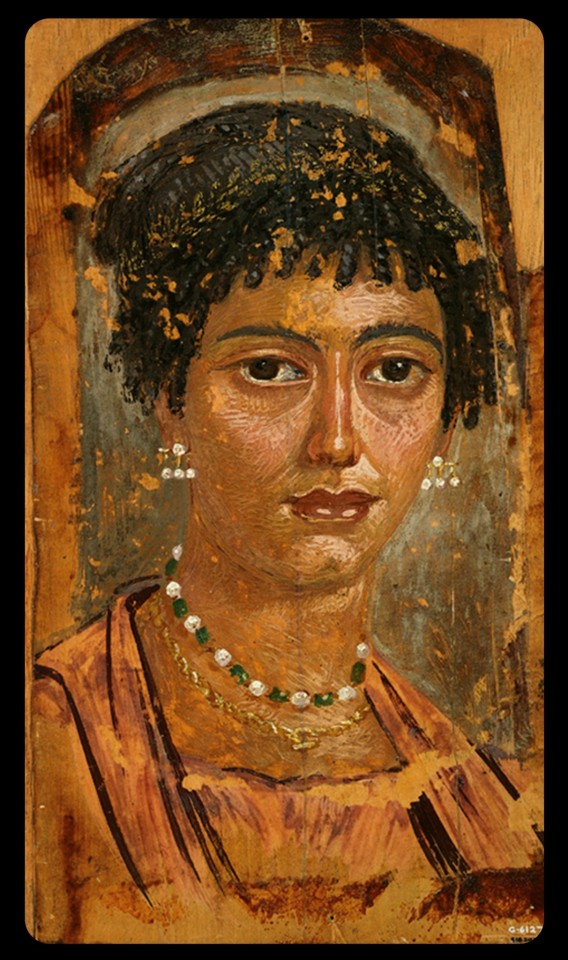
Above: Fayum portrait of a woman from Roman-occupied Egypt, c.100-110 CE
Fayum portraiture was a popular funerary practice among the upper-class families of Roman Egypt from about 50 CE to 250 CE. Given the high mortality rates for children during this period, many of these portraits depict children and youths, but adults were often featured, too.
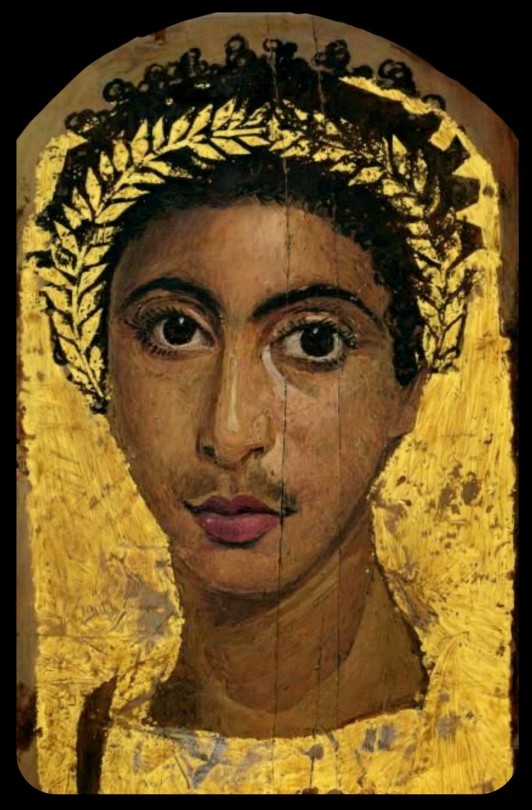
Above: portrait of a youth wearing a golden wreath, c.130-150 CE; the wreath and the background of the portrait are both gilded
The population of the Faiyum Delta, where most of these portraits were found, largely contained individuals with both native Egyptian/North African and Greek heritage. The Greek lineages can be traced back to the Ptolemaic period, when the Greeks gained control of Egypt and began to establish settlements throughout the region, gradually leading to a cultural diffusion between the Greek and Egyptian populations. The Romans eventually took control of Egypt in 31 CE, absorbing it into the Roman Empire and colonizing much of North Africa, but the demographics of the Faiyum Delta remained largely unchanged.

Above: portrait of a man with a mole on his nose, c.130-150 CE
Many of these Fayum portraits reflect the same blend of ethnic and cultural roots, depicting individuals with both Greek and native Egyptian heritage (a claim that is supported by both archaeological and genetic evidence). Some portraits may also depict native Egyptians who did not have any European ancestry, but had been integrated into Greco-Roman society.

Above: portrait of a bearded man, c.170-180 CE
These representations of native Egyptians provide us with unique insights into the actual demographics of Roman-occupied Egypt (and the ancient world at large). Non-European peoples are rarely included in depictions of the classical world; it's also interesting to see the blend of cultural elements that these portraits represent.

Above: portrait of a priest of Serapis, c.140-160 CE; the man in this portrait is shown wearing a fillet/crown that bears the seven-pointed star of the Greco-Egyptian god, Serapis
As this article explains:
In the 1800s and early 1900s, Western art historians didn’t know what to make of these portraits. Scholars of Roman history labeled them Egyptian. Scholars of Egyptian history labeled them Greco-Roman. These binary academic classifications failed to capture the true complexity of the ancient (or, indeed, modern) Mediterranean. In reality, Fayum portraits are a syncretic form, merging Egyptian and Greco-Roman art and funerary practices. They reflect the cosmopolitanism of both Roman and Egyptian history.
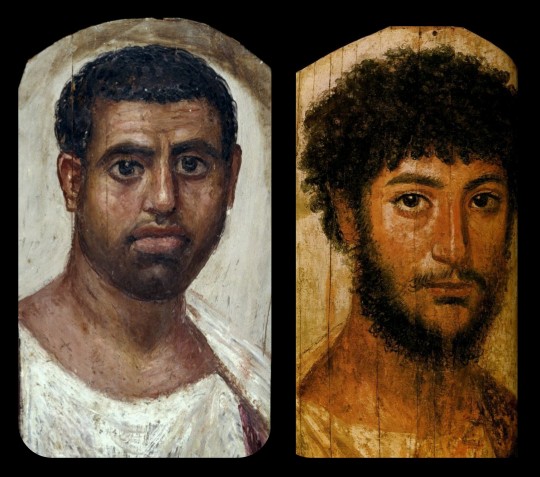
Above: portrait of a man, c.80-100 CE (left); portrait of a bearded officer, sometimes referred to as "Perseus," c.130-175 CE (right)
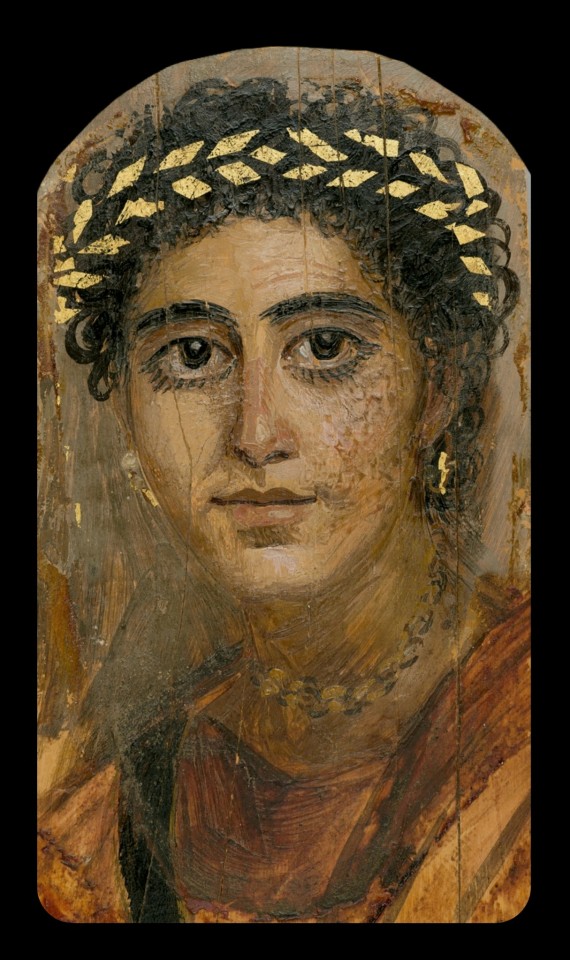
Above: portrait of a young woman in red, c.90-120 CE
Nearly 1,000 of these portraits are currently known to exist.

Above: portrait of a man wearing a gilded ivy wreath, c.100-150 CE
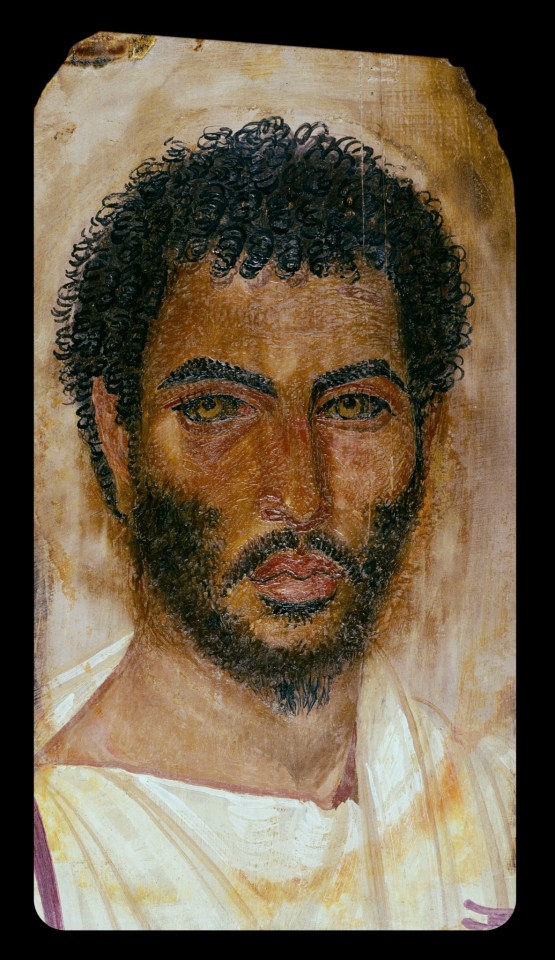
Above: portrait of a bearded man, c.150-170 CE
Sources & More Info:
Curationist: Fayum Portraits
Harvard Art Museums: Giving the Dead their Due: an Exhibition Re-Examines Funerary Portraits from Roman Egypt
Getty Museum: APPEAR Project
Getty Museum: Faces of Roman Egypt
National Geographic: Ancient Egypt's Stunning, Lifelike Mummy Portraits
The Athens Centre: The Myth of Whiteness in Classical Sculpture
Forbes: Whitewashing Ancient Statues: Whiteness, Racism and Color in the Ancient World
#archaeology#artifact#anthropology#history#ancient history#art#fayum portraits#roman egypt#ancient rome#ethnography#painting#portrait#north africa#people of color#egypt#religion#greco roman#greek#classical antiquity#fayum#mummy portraits#romano egyptian#representation
222 notes
·
View notes
Text
Retrogression by Dazai Osamu
is the #1 New Release in Japanese Literature!

"This book aims to piece together the fractured and disorderly lifestyle of one of history's greatest romantics and pairs it with a particular moment in his life; losing the Akutagawa Prize. The ensuing drama that unfolded through private letters, newspaper articles, diaries, obituaries, and fiction created a scandal that disturbed the early Showa literati with its coarse and indecent honesty. Dazai's fiction, fiction about Dazai, speculation and reality intertwined to create an explosive event that not only changed the desired trajectory of his life but also raised issues of discrimination within prominent literary circles and the treatment of mental illness in 1930s Japan."
- From the Introduction by translator A. L. Raye
Retrogression also includes annotations and background information on every story, letter, diary, and eulogy, adding history and insights that are difficult to find available in other English translations so far.
You can find more information and free translations on Yobanashi Café. Retrogression is available for purchase in either paperback or eBook format on Amazon.
143 notes
·
View notes
Text
Deal Announcement: WHEN THE TIDES HELD THE MOON (Erewhon, Spring 2025)
If you've been with me on Tumblr for a while, then you may already be familiar with this title and been waiting for this particular update, and all I can say is thank you endlessly for patiently sticking it out with me! I am so incredibly pleased to announce that WHEN THE TIDES HELD THE MOON has been acquired by Diana Pho at Erewhon Books/Kensington Publishing as an illustrated adult historical fantasy!

Tor.com has published a blush-inducing article which features some insights from me about what inspired the story, reactions from Hugo Award-winning editor Diana Pho on what drew her to the book, a downright tear-jerking endorsement from the incomparable TJ Klune, and my original concept art of Benny & Río. I hope you'll take a moment to read it at the link below!
This project is the culmination of a lifelong dream to write and illustrate my own books, and there are no words to convey the depth of my gratitude to Diana for the gift of seeing it be delivered as an illustrated adult work. Infinite thanks must also go to my unstoppable agent Saritza Hernandez, my phenomenal critique partners Anna Racine and Mark Duplane, and the many experts who generously and enthusiastically donated their time and resources in the middle of lockdown to help me bring 1911 Brooklyn, NY to life, including:
Virginia Sanchez-Korrol –– Professor Emeritus of Puerto Rican & Latino Studies, CUNY Brooklyn College
David Sharp -- President, The Waterfront Museum
Jamie Salen, David Favaloro, & Lana Rubin –– Marketing Director, Director of Curatorial Affairs, & Collections Manager (respectively), The Tenement Museum
Adam Realman -- Artistic Director, The Coney Island Circus Sideshow
More details about WTTHTM's release will be forthcoming, but in the meantime, thank you all again for believing in this story and supporting it when it was just a humble MerMay fic. I can't wait until you meet Benny and his beloved Río in print in 2025!
#wtthtm#benny and rio#brio!#when the tides held the moon#deal announcement#tj klune#erewhon books#kensington books
303 notes
·
View notes
Text
Fellow Travelers Timeline
(as comprehensive as i can make it. corrections/additions welcome)
1919-20 (?) - Hawk is born
based on tennis trophy which shows year 1936, and hawk's statement that he and kenny were on the tennis team in 11th grade (16/17 years old).

also date on the paperweight (1937) that hawk says kenny picked out on their senior trip. spring or fall though? if spring (usual for a senior trip, just before graduation), it would mean hawk graduated HS in 1937, b. 1919. (thanks, @lestatscunt!)

June 6, 1930 - Tim is born, on Staten Island, NY
birthdate/place shown on army application in ep 5
Gemini, with moon in Libra
>>> With a Gemini Sun Libra Moon, emotional equilibrium is hard for you to maintain in a world of constant flux and tension. Since you are not responsible for the woes and upsets of those around you, you should not feel so duty-bound to assuage their wounds or mediate every conflict that happens to come your way.
>>> your natural diplomacy, extraordinary perception and insight can all be applied creatively in such fields as politics, social work, and the mass media.
>>> your extreme open-mindedness would probably enable you to almost any life-style. You have a universal quality about you that transcends culture, religion, ideology, or any other barrier that divides mankind.
Fall 1937 - Spring 1941 - Hawk attends "Penn", presumably the University of Pennsylvania. (assuming hawk b. 1919)
(this is very very long, the rest is under the cut)
December 7, 1941 - bombing of Pearl Harbor, US enters WWII
??? - Hawk joins the army (along with Kenny), and is sent to Europe.
January 9 – August 15, 1945 - Battle of Luzon, where Kenny dies.
September 2, 1945 - Japan surrenders, US exits WWII
February, 1949 - Hawk starts working at the State Department
Hawk says in 1x04 (Dec 1953) that he's been working at the State Dept for "four years and ten months".
"I came out of the war with four assets: degree from Penn, a hero's war record, no particular political ideology, and a passing acquaintance with three languages. Throw in a talent for prevaricating and a taste for travel and fine clothes, you have the makings of a competent, mid-level Foreign Service bureaucrat."
Fall 1948 - Spring 1952 - Tim attends Fordham University, graduating with a degree in political science and history.
1951 - Hawk starts work for the Bureau of Congressional Relations
Tim mentions Hawk's been working there for two years during their meeting on the bench.
1952 - Tim works "the New York campaign" (presumably for Eisenhower).
1952/3? - Tim interns for three months at the Star, in the mailroom.
November 4, 1952 - Election Night, Eisenhower (R) wins the presidency. Tim/Hawk first meet and are instantly smitten. (ep 1)
February 16, 1953 to March 10, 1954 - McCarthy Hearings, part 1.
The first consisted of a series of hearings conducted by McCarthy, as the subcommittee’s chairman, throughout 1953 and early 1954 in which McCarthy alleged Communist influence within the press and the federal government, including the State Department, the U.S. Army, and the Government Printing Office.
March 5, 1953 - Stalin dies.
Late March, 1953 - Hawk/Tim second meeting
After Hawk meets Tim at the park bench, he attends a hearing where Marcus says Cohn has brought David Schine on, and then later at their lunch Senator Smith says, "McCarthy is sending Cohn and his sidekick to Europe..." This article, dated April 19, says that Cohn and Schine have been in Europe for two weeks.
Hawk mentions that it's near the end of the month, police need to make their quotas.

April 27, 1953 - Executive Order 10450 signed. Hawk goes to Tim's apartment and tells him about Kenny. (ep 1)
June 6, 1953 - Tim's 23rd birthday (Hawk 'misses' it because they weren't talking for 4 weeks. belated celebration in ep 3.)
June 15, 1953 (?) - date of the newspaper Tim is reading just before he goes to visit Hawk in ep 2, where Hawk makes him write the letter to Mary. I'm choosing to believe this is a mistake on the show's part, because this would mean that Hawk has already missed Tim's birthday.

June 19, 1953 - Julius and Ethel Rosenberg's execution. Hawk comforts Lucy about this at the end of ep 2. So, likely Hawk and Tim had their big fight very shortly before Tim's birthday, and weren't talking from end of May - end of June.
End of June, 1953 - at the end of ep 2, Tim says it's been 4 months since his last confession, making his last (proper) confession the end of Feb or beginning of March. (ie, before he meets Hawk again).
End of June or beginning of July, 1953 - weekend trip to Rehoboth Beach (ep 3)
November 1953 - G. David Schine drafted into the army (ep 3)
Christmas 1953 (ep 4)
March 16 to June 17, 1954 - Army-McCarthy Hearings (part 2) (ep 5)
The second phase involved the subcommittee's investigation of McCarthy’s attacks on the U.S. Army. Known as the “Army-McCarthy hearings,” they were broadcast on national television and they contributed to McCarthy’s declining national popularity. Five months later, on December 2, 1954, the Senate censured McCarthy.
June 6, 1954 - Tim's 24th birthday
June, 1954? - Tim/Hawk break up, Hawk proposes to Lucy (ep 5)
I believe this happens at the tail-end of the Army-McCarthy hearings, so before June 17th.
Fall, 1954 - Sen. Smith's funeral
based solely on fall foliage in this screenshot:

Late Nov / Early Dec, 1954 - Tim enlists in the army
based on army application: birthdate 6/6/30, age: 24 years, 6 months
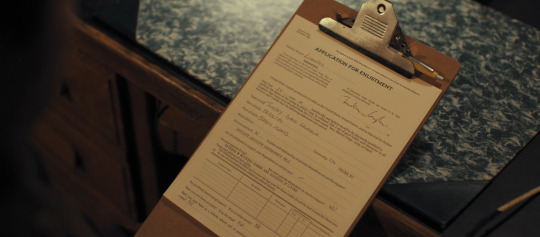
Late Nov / Early Dec, 1954 - Hawk/Tim last meeting in the tower
based on the radio program Tim is listening to, which says, "Chief Counsel Roy Cohn has resigned from the committee. And Senator McCarthy, his approval ratings plummeting, faces censure or even expulsion from the Senate."
Tim leaves for Fort Dix, for training, but is later stationed at Fort Polk, in Vernon Parish, LA. (thanks, @jesterlesbian!)

December 2, 1954 - the Senate censures McCarthy.
Summer or Fall 1956? - Tim's letter (that lucy burns) (ep 6)
Flashbacks, for context:
"Since he's giving up his apartment, Hawk insists on having a lair in the woods." // "I'm surprised that he finally agreed."
Lucy lets contractor go. // "Give me a baby."
Hawk is reading the Bristol Daily Courier, a paper located in Bristol, PA, a town in Bucks County, outside Philadelphia. I can't find any info on the one headline I can read though ("Heath Carlson breaks arws deadlock, locals proud"), so can't date this properly.
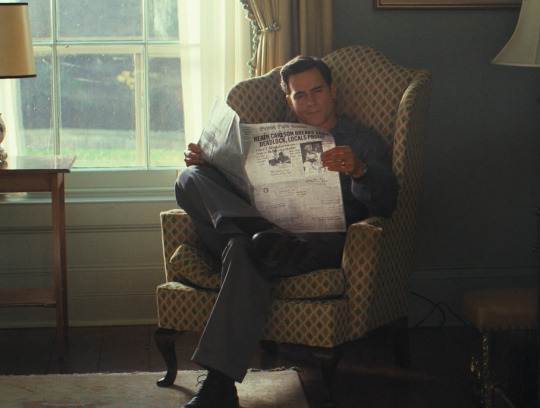
Lucy cleaning out Hawk's apartment, finds paperweight, sees Tim drop off letter.
"I went into the Army to get away from you. I thought time and distance would help. But it hasn't." If Tim sends the letter in summer 1956, it's been a year and a half since he enlisted.
Biggest question here: did lucy ask for a baby before or after she read Tim's letter??? the flashbacks don't answer this definitively.
October, 1956? - Lucy becomes pregnant with Jackson (see note under April 1957)
October 23 – November 4, 1956 - Hungarian Revolution of 1956
October 23, 1956 - April 30, 1957 - Hungarian Refugee Crisis
November 8, 1956 - Operation Safe Haven commences
President Eisenhower declared that 5,000 Hungarians would be awarded visa numbers remaining under the 1953 Refugee Relief Act
Spring 1957? - Tim sends telegram. It looks like 05-??-???? to me, which doesn't really make sense if McCarthy died on May 2nd, but it's hard to make out. or maybe telegrams used the date format dd-mm-yyyy.

April 1957? - Tim/Hawk first meeting, Lucy at least 5 (or 6? or 7?) months pregnant
You should feel your baby's first movements, called "quickening," between weeks 16 and 25 of your pregnancy. If this is your first pregnancy, you may not feel your baby move until closer to 25 weeks.
25 weeks ~= 6 months, and it still seems novel to her, so let's say she's approx. 6 months pregnant here.


May 2, 1957 - Joe McCarthy dies.
May 6, 1957 - McCarthy's funeral. Tim's first visit to Hawk's apartment (ep 8)
June 6, 1957 - Tim turns 27.
June or July, 1957 - Jackson born (based on dates above)

1958? - Kimberly is born. (estimated bc she looks the same age or older than Jackson, so assuming she's a year younger at most.)
August, 1965 - President Johnson signs a law making it a federal crime to destroy or mutilate [draft] cards.
October 15, 1965 -David Miller publicly burns his draft card, becoming the first person to be prosecuted under that law and a symbol of the growing movement against the war.
May 17, 1968 - the Catonsville Nine took 378 draft files from the draft board office in Catonsville, Maryland and burned them in the parking lot. (inspo for Tim & co. thanks @brokendrums!)
November 1968 - ep 6. Hawk is 48-9, Tim is 38, Jackson is 11.
based on this newspaper screenshot when Hawk is talking to Marcus on the phone about Tim

November 1968 - May 1970 (earliest) - Tim in prison. (he says in ep 7 he was in prison for a year and a half. this assumes he went to prison right away, but it could have been several months later if he was awaiting trial/sentencing.)
1970? - After prison, Tim moves to San Francisco and gets his counseling degree.
Mid-late 1970s - Tim earns his C-SWCM qualifications, requiring:
A Bachelor’s degree in social work from a graduate program accredited by the Council on Social Work Education
Documentation of at least three (3) years and 4,500 hours of paid, supervised, post-BSW professional experience in an organization or agency that provides case management services
Current state BSW-level license or an ASWB BSW-level exam passing score.
nb. because Tim already had his bachelors (from Fordham, majoring in history), I could see him entering a much-accelerated BSW program, transfering a lot of credits from his previous degree. That would give him maybe 2 more years of university, plus the required 3 years of post-BSW work = 5 years minimum before he earns that business card.
February 4, 1977 - Fleetwood Mac's album Rumours is released, including the 1970s Tim/Hawk anthem, Go Your Own Way
October, 1978 - Jackson dies

November 27, 1978 - Harvey Milk assassinated
May 20-22, 1979 - Tim on Fire Island (ep 7). Hawk is 59 or 60, Tim is 48, about to turn 49.
May 22, 1979 - Harvey Milk's (posthumous) 49th birthday (celebrated in ep 7)
1986 - ep 8
how long was Hawk in San Francisco? Timelines for the events below may be fudged in the show, bc I doubt he was there for 5 months.
March, 1986 - Roy Cohn's 60 Minutes interview, which the gang watches in ep 4.
April 15, 1986 - US bombs Libya. in the first episode you can hear reference to this on the radio, before Hawk leaves for San Francisco. (thanks @aliceinhorrorland93!)
July 27, 1986 - In California, Gov. George Deukmejian vetoes a bill that would have defined AIDS as a physical handicap calling for entitlement to protection under the state's civil rights laws.
August 2, 1986 - Roy Cohn dies (ep 8)
Late 1986? - the fundraising gala that Tim crashes, shortly after Cohn's death.
September 1986 - The State Legislature has passed another bill [in addition to the one vetoed on July 27]. Mr. Deukmejian, a Republican running for re-election, has indicated that he will probably veto the bill. (nb, this is likely the bill that Tim & co want to pressure the governor to sign).
October 11, 1987 - AIDS memorial quilt first displayed (ep 8)
--
this was a collaborative effort! many thanks to @ishipallthings for many of these details, as well as @startagainbuttercup , @alorchik, @itsalinh and others in the FT discord!
#fellow travelers#timeline#reference#i made this as comprehensive as i could but i would LOVE feedback/corrections#esp re: anything in 1956-1957 era#jackson's birth? and the date of that letter???
286 notes
·
View notes
Text
Person ≠ Human = Person
(For clarity, that title should be read as "Person does not equal Human equals Person".)
I've seen a fair few posts over the years I've been involved in the community where someone gets upset by the use of "people" as an umbrella term, generally also claiming that "person" refers exclusively to humans, and therefore the term excludes non-humans.
That is wrong, and it shows that there is a very important conversation that should be happening but isn't.
First thing's first, [this] is the Wikipedia article on "Personhood". I'm going to recommend reading it in full, but if you don't have time or don't want to, the most relevant parts for this are the opening paragraphs (up to the "Philosophy" header) and the sub-headings "Non-human animals" and "Hypothetical beings", both under the "Debates" heading. Those sections should provide some insight into what I'm going to be talking about here, and give you an idea of that conversation that should be happening.
With that out of the way, let's talk about what it means to be a "person", and why it's wrong to claim that it's synonymous with "human". The state of being a "person" (that is, personhood) is less of a biological classification and more of a social one. A person is someone who is deserving of basic rights and decency, which I would hope we can all agree is not a category exclusive to humans. Exactly where the line between "person" and "non-person" lies has been debated extensively for a very, very long time, but there is at least one solid standard that everyone should be able to agree with:
A person is a sapient, thinking being capable of recognizing itself as being a person.
If you are reading this right now, I'm going to assume that you meet that definition, which makes you a person, and that is a good thing. It means you are a being which deserves basic rights like the ability to engage with society, own property, and exercise your free will. Saying you're not a "person" because you're non-human is saying that you shouldn't get to enjoy those basic rights, and that you should not be included in society and allowed to act as an independent being.
All humans are people, but that does not mean that all people are human. And it's worth noting that declaring categories of humans as not being people has been an important part of excusing the removal of basic rights from them. You see it in the way that slaves were talked about prior to the practice being outlawed, and in the way that fascists talk about the groups that they think should be killed en masse. Declaring those groups as not being "people" dehumanizes them, not because being a person means being human, but because being human means also being a person.
There very clearly needs to be an ongoing conversation in the community about non-human personhood, because it is a topic with a long history, with strong points made in favour of including all manner of non-humans under the umbrella of "person". This ongoing trend of declaring oneself to not be a person because of non-humanity is, put bluntly, foolish at best and actively dangerous at worst. Everyone has personhood. It came free with your being a sapient being, capable of thought and self-reflection.
And bonus conversation topic: The reason that anti-kin and related groups do the whole, "Oh, you're not human? Does that mean I can treat you like an animal?" bit is because they don't see non-humans as having personhood. Consider how it would affect how they approach our communities if they were open to the concept of non-human personhood, and how that could further benefit the community as a whole.
Discuss.
#personhood#non-humanity#non-human personhood#otherkin#therian#were#alterhuman#nonhuman#non-human#rant/rave
295 notes
·
View notes
Text
Hi everyone,
I found this interesting article about screen time and its connection to Autism and ADHD. Here’s an excerpt:
A recent study from Drexel University reveals alarming new insights into the effects of screen time on toddlers.
The research suggests that babies and toddlers exposed to television or video viewing may exhibit atypical sensory behaviors and have difficulty processing the world around them.
Atypical sensory behaviors include being disengaged, seeking more intense stimulation, or being overwhelmed by sensory inputs such as loud sounds or bright lights.
The full article will be below in case any one else wants to read it.
#autism#adhd#screen time#study#research#neurodivergence#neurodiversity#actually neurodivergent#feel free to share/reblog#source: Earth.com
329 notes
·
View notes